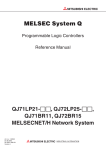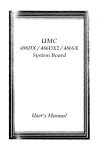Download E586-ICP / E586-IPE
Transcript
E586-ICP E586-IPE System Board User’s Manual - D23540520 - v Copyright1994,byDFIInc. All rights reserved. No part of this document may be copied or reproduced in any form or by any means without the prior written consent of DFI, Inc. DFI, Inc. makes no warranties with respect to this documentation and disclaims any implied warranties of merchantability, quality, or fitness for any particular purpose. The information in this document is subject to change without notice. DFI, Inc. reserves the right to make revisions to this publication and to make changes to any and/or all parts of its content, at any time, without obligation to notify any person or entity of such changes. Further, DFI, Inc. assumes no responsibility for any errors that may appear in this document. DFI is a registered trademark, and E586-ICP/E586-IPE is a trademark of Diamond Flower, Inc. All other product names mentioned are trademarks or registered trademarks of their respective companies. v FCC Statement on Class B This equipment has been tested and found to comply with the limits for a Class B digital device, pursuant to Part 15 of the FCC rules. These limits are designed to provide reasonable protection against harmful interference when the equipment is operated in a residential installation. This equipment generates, uses, and can radiate radio frequency energy and if not installed and used in accordance with the instruction manual may cause harmful interference to radio communications. However, there is no guarantee that interference will not occur in a particular installation. If this equipment does cause harmful interference to radio or television reception, which can be determined by turning the equipment off and on, the user is encouraged to try to correct the interference by one or more of the following measures: • Reorient or relocate the receiving antenna. • Increase the separation between the equipment and the receiver. • Connect the equipment into an outlet on a circuit different from that to which the receiver is connected. • Consult the dealer or an experienced radio TV technician for help. Notice: 1. The changes or modification not expressly approved by the party responsible for compliance could void the user's authority to operate the equipment. 2. Shielded interface cables must be used in order to comply with the emission limits. v Table of Contents v Introduction ................................................................................. 1-1 Features and Specifications ................................................. 1-2 Package Checklist ................................................................. 1-2 Installation Overview ................................................................. Preparing the Area ................................................................ Handling the System Board .................................................. Tips in Handling the System Board ............................... Hardware Installation ............................................................. Memory Installation ......................................................... Installing the Modules .............................................. Board Configuration ........................................................ Jumper Settings ....................................................... Cache Configuration ................................................ Jumper Settings for Cache Memory ................. CPU Installation .............................................................. Jumper Settings for CPU ........................................ Installing Upgrade CPUs ........................................ Installing the System Board .................................................. Installing the PS/2 Mouse Port ............................................. 2-1 2-1 2-2 2-2 2-2 2-2 2-6 2-7 2-9 2-13 2-15 2-16 2-17 2-18 2-22 2-24 Initial Setup Program ................................................................. Award BIOS CMOS Setup Utilities ...................................... Standard CMOS Setup .................................................. BIOS Features Setup ..................................................... Chipset Features Setup ................................................. PCI Slot Configuration ................................................... Load BIOS Defaults ....................................................... Load Setup Defaults ...................................................... Password Setting ........................................................... IDE HDD Auto Detection ............................................... Save & Exit Setup .......................................................... Exit Without Saving ........................................................ 3-1 3-2 3-2 3-5 3-7 3-8 3-9 3-9 3-10 3-11 3-11 3-12 EISA Configuration Utility ....................................................... Troubleshooting Checklist ...................................................... 4-1 5-1 Appendix A: Types of Modules .............................................. Appendix B: System Error Report ......................................... Appendix C: Memory & I/O Maps ........................................... Appendix D: EISA I/O Pin Assignments ................................ Appendix E: PCI I/O Pin Assignments .................................. Appendix F: Connector Pin Assignments ............................ Appendix G: Award BIOS Hard Disk Table ........................... A-1 B-1 C-1 D-1 E-1 F-1 G-1 This page left intentionally blank. Read Me First The E586-ICP/E586-IPE system board requires the installation of the ECU (EISA Configuration Utility), found on the provided EISA Configuration Utility diskette, for proper operation of this system board. The ECU configures the EISA devices and maintains system parameters by storing them in the Extended CMOS Memory, so the BIOS can initialize the system and expansion boards inserted in the EISA slots once you power up your system. The Extended CMOS Memory is equipped with an internal battery that needs to be constantly charged. In a small number of cases, the internal battery may have drained and the information stored in the Extended CMOS Memory lost during shipment. If this happens, you will get the message "EISA CMOS Inoperational" when you power up your system. Simply run the ECU software, bundled with the system board, to reconfigure the system. Save the configuration and reboot your system. Refer to the EISA Configuration Utility section on page 4-1 for more detailed information. EISA/PCI System Board v Introduction The E586-ICP/E586-IPE system board offers several advanced features integrated into the system board. It is designed based on the new PCI (Peripheral Component Interconnect) local bus and EISA (Extended Industry Standard Architecture) standards. The E586-ICP/E586-IPE supports 273-pin Zero Insertion Force socket for PentiumTM processors running at 60MHz or 66MHz bus speed. It also supports an optional Flash EPROM. Flash EPROM is a memory chip for the storage of BIOS which can be erased in bulk or modified using a software utility. The E586-ICP/E586-IPE comes with an EISA Configuration Utility (ECU) that must be installed and run to configure the board and the EISA expansion boards that will be inserted in the EISA expansion slots. The E586-ICP/E586-IPE system board is equipped with four EISA and four PCI local bus slots. One EISA slot and one PCI slot are shared, meaning you may use only one or the other of these three slots. Therefore, in accord with the PCI standard, seven slots are useable. The E586-ICP/E586-IPE is also equipped with one mini-DIN-6 connector for the PS/2 mouse and an optional IDE disk interface, only if installed with the Symphony SL82C101P chip. The E586-ICP/E586-IPE can be configured to twentytwo different sizes from 2MB to 128MB using 256Kx36, 512Kx36, 1Mx36, 2Mx36, 4Mx36 and 8Mx36 HSIM modules. 1-1 u Introduction E586-ICP/E586-IPE Features and Specifications • Microprocessor PentiumTM Processor • Chipset Intel 82430 PCI: system Symphony SL82C101P: PCI IDE (optional) • BIOS Award system BIOS • Cache Memory 256K or 512K Burst (sync) SRAM for 3-1-1-1 Level 2 cache access (E586-ICP) 256K or 512K Async SRAM for 3-2-2-2 Level 2 cache access (E586-IPE) Supports direct map write-back or write-through cache subsystem Integrated cache tag RAM • Memory Onboard 2MB to 128MB • DRAM Type 256Kx36, 512Kx36, 1Mx36, 2Mx36, 4Mx36 and 8Mx36 SIMM Supports single and/or double density SIMMs Supports DRAM access time of 60ns or 70ns Supports page mode • ZIF Socket 273-pin ZIF socket (Intel Socket 4) Introduction u 1-2 EISA/PCI System Board • Slots Three 32-bit PCI slots One shared - PCI/EISA slot Three 32-bit EISA slots • Connectors A mini-DIN-6 connector for the PS/2 mouse One IDE disk interface (optional; only if installed with the Symphony SL82C101P chip) • Tooling Holes Baby AT form factor • PCB 4 layers Package Checklist The E586-ICP/E586-IPE package contains the following items: • • • • • The E586-ICP/E586-IPE system board The E586-ICP/E586-IPE user’s manual One EISA Configuration Utility diskette One DB-25S hole cover holding the PS/2 mouse port One 40-pin IDE hard disk cable (optional) If any of these items is missing or damaged, please contact your dealer or sales representative for assistance. 1-3 u Introduction E586-ICP/E586-IPE v Installation Overview This chapter summarizes the steps in installing the E586-ICP/E586-IPE system board into your system unit. It also includes a description of the area in which you must work and directions for memory installation. Before installing the system board, obtain the memory you plan to install. Preparing the Area Before unpacking the system board, make sure the location you have selected is relatively free of dust and static. Excessive exposure to dust, static electricity, direct sunlight, excessive humidity, extreme cold and water can damage the operational capabilities of your system board. Avoid soft surfaces such as beds and carpeted floors which can hinder air circulation. These areas also attract static electricity which can damage some circuits on your system board. Be sure that the power source has a properly grounded, three-pronged socket. It is essential that the power connection be properly grounded for correct functioning of your system board. For further protection, we recommend that you use a surge protection socket. This will protect the system board from damage that may result from a power surge on the line. Move items that generate magnetic fields away from your system board, since magnetic fields can also damage your system board. Once you have selected the ideal location, unpack the E586-ICP/E586-IPE system board carefully. Installation Overview u 2-1 EISA/PCI System Board Handling the System Board It is quite easy to inadvertently damage your system board even before installing it to your system unit. Static electrical discharge can damage computer components without causing any signs of physical damage. You must take extra care in handling the system board to ensure that no static build-up is present. Tips in Handling the System Board 1) To prevent electrostatic build-up, leave the board in its anti-static bag until you are ready to install it. 2) Wear an antistatic wriststrap. 3) Do all preparation work on a static-free surface with components facing up. 4) Hold the system board by its edges only. Be careful not to touch any of the components, contacts or connections, especially gold contacts on the board. 5) Avoid touching the pins or contacts on all modules and connectors. Hold modules and connectors by their ends. Hardware Installation Memory Installation The E586-ICP/E586-IPE system board can support 2MB to 128MB of memory using HSIMMs. HSIMM is an acronym for High Density Single In-line Memory Module. 2-2 u Installation Overview E586-ICP/E586-IPE An HSIMM consists of several RAM chips soldered onto a small circuit board. An HSIMM connects to the system board via a 72-pin card-edge connector. The HSIMM sockets are divided into two banks on the system board. The E586-ICP/E586-IPE system board uses 256Kx36, 512Kx36, 1Mx36, 2Mx36, 4Mx36 and 8Mx36 HSIM modules. You will need 2 to 4 pieces of HSIM modules, depending on the amount of memory you intend to install. Your system board can be configured with 2MB, 4MB, 6MB, 8MB, 10MB, 12MB, 16MB, 18MB, 20MB, 24MB, 32MB, 34MB, 36MB, 40MB, 48MB, 64MB, 66MB, 68MB, 72MB, 80MB, 96MB or 128MB of onboard memory. To install the HSIM modules, first populate Bank 1 and then Bank 2. Failure to do so will cause the system board to work improperly. The following table summarizes the bank locations and modules needed for the corresponding memory sizes. Each bank consists of 2 HSIMM sockets. MemorySize 2MB 4MB 4MB 6MB 6MB 8MB 8MB Bank1 Bank2 256Kx36 256Kx36 512Kx36 256Kx36 512Kx36 512Kx36 1Mx36 256Kx36 512Kx36 256Kx36 512Kx36 - Installation Overview u 2-3 EISA/PCI System Board MemorySize Bank1 Bank2 10MB 10MB 12MB 12MB 16MB 16MB 18MB 18MB 20MB 20MB 24MB 24MB 32MB 32MB 34MB 34MB 36MB 36MB 40MB 40MB 48MB 48MB 64MB 64MB 66MB 66MB 68MB 68MB 72MB 72MB 80MB 80MB 96MB 96MB 128MB 256Kx36 1Mx36 512Kx36 1Mx36 1Mx36 2Mx36 256Kx36 2Mx36 512Kx36 2Mx36 1Mx36 2Mx36 2Mx36 4Mx36 256Kx36 4Mx36 512Kx36 4Mx36 1Mx36 4Mx36 2Mx36 4Mx36 4Mx36 8Mx36 256Kx36 8Mx36 512Kx36 8Mx36 1Mx36 8Mx36 2Mx36 8Mx36 4Mx36 8Mx36 8Mx36 1Mx36 256Kx36 1Mx36 512Kx36 1Mx36 2Mx36 256Kx36 2Mx36 512Kx36 2Mx36 1Mx36 2Mx36 4Mx36 256Kx36 4Mx36 512Kx36 4Mx36 1Mx36 4Mx36 2Mx36 4Mx36 8Mx36 256Kx36 8Mx36 512Kx36 8Mx36 1Mx36 8Mx36 2Mx36 8Mx36 4Mx36 8Mx36 2-4 u Installation Overview E586-ICP/E586-IPE Bank 2 82433LX 82433LX Bank 1 Pin 1 of the HSIMM socket SL82C101P 82434 82375 ZIF Socket 82374 Locations of the HSIMM Sockets on the System Board Installation Overview u 2-5 EISA/PCI System Board Installing the Modules HSIMMs simply snap into a socket on the system board. Pin 1 of the HSIMM must correspond with Pin 1 of the socket. 1. Position the HSIM module above the HSIMM socket with the chips of the module facing the center of the system board. 2. Seat the module at an angle into the bank. Make sure it is completely seated. Tilt the module upright until it locks in place in the socket. 2-6 u Installation Overview E586-ICP/E586-IPE Board Configuration The E586-ICP/E586-IPE is designed with jumpers and connectors onboard. Make sure that the jumpers are set correctly before installing the system board into your system unit. PL1 PL2 JP3 J1 JP22 J2 JP24 82433LX JP5 JP6 SL82C101P 82433LX JP8 JP18 JP10 PCI Slot - Slave JP27 JP15 82434 JP23 JP12 PCI Slot - Master/Slave JP25 JP19-JP21 JP16 JP1 PCI Slot - Master/Slave JP2 PCI Slot - Master/Slave J3 J4 82375 ZIF Socket EISA Slot EISA Slot EISA Slot EISA Slot 82374 JP7 J6 JP11 JP13 J7 JP14 Flash EPROM JP26 JP28 Locations of Jumpers and Connectors on the E586-ICP System Board Installation Overview u 2-7 EISA/PCI System Board PL1 PL2 JP22 J2 JP23 JP3 J1 82433LX JP5 JP6 SL82C101P 82433LX JP8 JP17 JP10 PCI Slot - Slave JP70 JP15 JP18 82434 JP12 PCI Slot - Master/Slave JP16 JP1 PCI Slot - Master/Slave JP2 PCI Slot - Master/Slave J3 J4 82375 ZIF Socket EISA Slot EISA Slot EISA Slot EISA Slot 82374 JP7 JP13 J7 JP14 Flash EPROM Locations of Jumpers and Connectors on the E586-IPE System Board 2-8 u Installation Overview J6 JP11 JP26 JP28 E586-ICP/E586-IPE Jumper Settings Jumper JP1 PCI Edge-Triggered Interrupt Jumper JP1 is used to select the PCI edge-triggered interrupt of the E586-ICP/E586-IPE system board. Set JP1 according to the table shown below. JP1 1-2 3-4 5-6 7-8 9-10 On On On On On INT IRQ Int. A Int. A Int. B Int. C Int. D IRQ15 IRQ14 IRQ11 IRQ10 IRQ9 IRQ IRQ IRQ IRQ IRQ 15 14 11 10 9 2 10 1 9 A A B C D Installation Overview u 2-9 EISA/PCI System Board Jumpers JP3 and JP5 Built-in IDE The E586-ICP/E586-IPE system board is equipped with a built-in IDE disk interface, only if installed with the Symphony SL82C101P chip. Set JP5 to On to enable the built-in IDE. Set JP3 to On to disable the built-in IDE. JP3 On: IDE Disabled (Default) JP5 On: IDE Enabled Jumpers JP6 and JP8 Parity Enable/Disable Set Jumpers JP6 and JP8 to On to enable the SRAM’s parity bit. On: Parity Enabled (Default) 2-10 u Installation Overview Off: Parity Disabled E586-ICP/E586-IPE Jumper JP7 PS/2 Mouse The E586-ICP/E586-IPE package includes a DB-25S hole cover that holds the PS/2 mouse port. The PS/2 mouse port uses IRQ12. If you set Jumper JP7 to IRQ12 enable, make sure you connect the PS/2 mouse port to Connector J1. On: IRQ12 Enabled (Default) Off: IRQ12 Disabled Jumper JP11 Display Type Select Jumper JP11 sets the display adapter to color or mono. This jumper must match the type of display adapter installed. If you change your video adapter, make sure this jumper is changed accordingly. 1 2 3 1-2 On: Color (Default) 1 2 3 2-3 On: Mono Installation Overview u 2-11 EISA/PCI System Board Jumper JP13 Password Clear If you set a password in the “Password Setting” option and forget your password, power off your system and set Jumper JP13 to On to clear the password stored in your CMOS. Now power on your system. After your system has detected the floppy or hard drive, turn it off again and set JP13 to Off. On: Clear Password Off: Normal (Default) Jumper JP26 Flash EPROM Jumper JP26 should be set to match the type of Flash EPROM installed on the E586-ICP/E586-IPE system board. See page 2-7 and 2-8 for the location of the Flash EPROM installed on your system board. 1 2 3 1-2 On: Flash EPROM (Default) 2-12 u Installation Overview 1 2 3 2-3 On: Normal EPROM E586-ICP/E586-IPE Cache Configuration The E586-ICP/E586-IPE system board can be configured to two different cache sizes: 256KB and 512KB. 256KB of cache memory is the default size. The system board supports direct map write-back or write-through cache subsystem with tag RAM integrated into the chipset. The E586-ICP uses Burst SRAM for fast 3-1-1-1 Level 2 cache access. The E586-IPE uses Async SRAM for 3-2-2-2 Level 2 cache access. 82433LX 82433LX SRAM SRAM SRAM SRAM SL82C101P 82434 82375 ZIF Socket 82374 Locations of the SRAMs on the E586-ICP System Board Installation Overview u 2-13 EISA/PCI System Board 82433LX SL82C101P 82433LX SRAM SRAM SRAM SRAM SRAM SRAM SRAM SRAM 82434 82375 ZIF Socket 82374 Locations of the SRAMs on the E586-IPE System Board 2-14 u Installation Overview E586-ICP/E586-IPE Jumper Setting for Cache Memory Jumper JP15 Level 1 Cache The Level 1 cache of the PentiumTM processor supports Write Back and Write Through cache subsystem. Set JP15 as shown below. On: Write Through Off: Write Back (Default) Jumpers JP22 and JP23 Level 2 Cache If you have upgraded the cache size of your E586-ICP/ E586-IPE system board, change Jumpers JP22 and JP23 as shown below. 1 L2 Cache JP22 JP23 512KB 256KB* None 2-3 On 1-2 On 1-2 On 2-3 On 2-3 On 1-2 On 2 3 1-2: On 1 2 3 2-3: On Installation Overview u 2-15 EISA/PCI System Board CPUInstallation The E586-ICP/E586-IPE is equipped with a 273-pin Zero Insertion Force (ZIF) socket on location U29 of the system board. Make sure the jumpers are set correctly before applying power, or you may damage the CPU or system board. 82433LX 82433LX SL82C101P 82434 U29 82375 ZIF Socket 82374 Location of Pin 1 Location of the ZIF Socket on the E586-ICP/E586-IPE System Board 2-16 u Installation Overview E586-ICP/E586-IPE JumperSettingsforCPU Jumper JP18 CPU Speed Set Jumper JP18 according to the speed of the CPU installed on the E586-ICP/E586-IPE system board. On: 60MHz (Default) Off: 66MHz The jumpers below are for factory testing only and should always be set to their default configurations. Reconfiguring these jumpers will cause problems with your E586-ICP or E586-IPE system board. JP10: 2-3 On JP12: On JP14 and JP16 : Off JP17 and JP70: Off (E586-IPE) JP19-JP21, JP24 & JP25: 2-3 On (E586-ICP) JP27: Off (E586-ICP) Installation Overview u 2-17 EISA/PCI System Board Installing Upgrade CPUs The E586-ICP/E586-IPE is equipped with a 273-pin Zero Insertion Force (ZIF) socket at location U29 of the system board. Warning: Open the socket only if actually installing a CPU. The warranty on the original CPU will be voided if the S/N seal is broken. Installation of the PentiumTM Processor will not affect the original system warranty. The 273-pin ZIF socket consists of four rows of pin holes on each side. Zero Insertion Force (ZIF) Socket 2-18 u Installation Overview E586-ICP/E586-IPE To install, simply move the handle upward. Remove the original CPU from the socket. Position the CPU above the socket. Make sure pin 1 of the CPU is aligned with pin 1 of the socket. Lower the chip until the pins are inserted properly in their corresponding holes. Pin 1 of the ZIF Socket Installation Overview u 2-19 EISA/PCI System Board Lifting the Handle Positioning the CPU Above the ZIF Socket 2-20 u Installation Overview E586-ICP/E586-IPE Gently push the handle down until the handle locks into place. You will hear a click when the handle is secure. When you want to remove the chip, simply lift the handle and remove the chip. Warning: The cables (floppy drive, hard drive, CD-ROM, etc.) must be routed clear of the CPU with a minimum of 0.25" horizontal clearance to allow heat dissipation. A minimum of 1.4" vertical clearance (measured above the socket surface) must be kept free above the CPU. Do not run cables or other obstructions in this area. Adequate airflow for cooling must be provided over the CPU. For PentiumTM Processors, the airflow must be adequate to keep the system temperature below 40oC, measured 0.5 inch above the CPU and assuming a room temperature of 25oC. Installation Overview u 2-21 EISA/PCI System Board InstallingtheSystemBoard Before installing the system board into your system unit, you should prepare the tools you will use: You will need: • one medium size, flat-bladed screwdriver • one medium Philips screwdriver Step 1 Unlock your system unit. Turn off the power and disconnect all power cords and cables. Step 2 Remove the system unit cover. Refer to the manufacturer's instructions if necessary. Step 3 Remove expansion cards seated in any of the expansion slots and detach all connectors from the old system board. Step 4 Loosen the screws holding the original system board and remove the board from the system. Save the screws. 2-22 u Installation Overview E586-ICP/E586-IPE Step 5 Insert the SIM modules into the SIMM banks on the E586-ICP/E586-IPE. The quantity and location of the SIM modules is dependent upon the memory configuration and type of modules you intend to use. Step 6 Set the corresponding jumpers. Step 7 Install the prepared E586-ICP/E586-IPE system board into the case and replace the screws. Step 8 Reinstall all cards and connectors and replace the system unit cover. Reconnect all power cords and cables. Installation Overview u 2-23 EISA/PCI System Board InstallingthePS/2MousePort The E586-ICP/E586-IPE package includes a DB-25S hole cover that holds the PS/2 mouse port attached with a ribbon cable. To install: 1. Use the two screws provided with the package to secure the DB-25S hole cover to the DB-25S hole normally found at the rear of a system chassis. 2. Connect the cable to Connector J1 of the system board. 2-24 u Installation Overview E586-ICP/E586-IPE v InitialSetupProgram After you power up your system, the BIOS message appears on your screen and the memory count begins. After the memory test, the following message will appear on the screen: Press CTRL-ALT-ESC/DEL to enter setup If the message disappears before you respond, restart your system or press the “Reset” button. You may also restart the system by pressing the <Ctrl> <Alt> <Del> keys. If you do not press these keys at the correct time and the system does not boot, the following error message will appear: Press F1 to continue, Ctrl-Alt-Esc or Del to enter Setup If you have set a password and selected “System” in the Security Option of the BIOS Feature Setup menu, you will be prompted for the password everytime the system is rebooted or any time you try to enter Setup. Type in the correct password and press <Enter>. If you selected “Setup” in the Security Option, you will be prompted for the password only when you try to enter Setup. Refer to the “BIOS Features Setup” section for more information. Initial Setup Program u 3-1 EISA/PCI System Board Award BIOS CMOS Setup Utility Press <Ctrl> <Alt> <Esc> or <Del> to enter the Setup utility. A screen similar to the one below will appear. Use the arrow keys to highlight the option you want and press <Enter>. Standard CMOS Setup Use the arrow keys to highlight the “Standard CMOS Setup” and press <Enter>, a screen similar to the one on the next page will appear. 3-2 u Initial Setup Program E586-ICP/E586-IPE Date and Time Sets the time and date for the system. Press <F3> for the calendar. Drive C and Drive D If you have added a hard drive, you must select the appropriate type for the drive. The E586-ICP/E586-IPE has 46 pre-set types and one user-definable type. Use the <Page Up> or <Page Down> keys to select the appropriate type for the drive. The table in Appendix G gives a complete listing of the available drive types. Any given hard drive must be set to one specific drive-type number. Please refer to your hard drive documentation to find the appropriate type number. Initial Setup Program u 3-3 EISA/PCI System Board If none of the pre-set types is appropriate for your hard drive, choose “User”, which is the user-definable type. To use this type, highlight either hard disk C or D, depending on your hard drive configuration. Use the arrow keys until type “User” is showing. Fill in all the parameters as specified by the drive manufacturer. If either of the drives is not present, select “None” and press <Enter>. Drive A and Drive B These options are used to select the type of floppy disk drives installed in your system. If either of the drives is not present, select “None”. Make sure you choose the correct drive type; otherwise, your system might improperly format the device. Video This is used to select the type of video adapter installed in your system. Halt on This option selects when the system will halt if an error is detected during power up. No Errors: The system boot will not stop for any errors detected. All Errors: The system will stop whenever the BIOS detects a non-fatal error. All, But Keyboard: The system will stop for any errors except a keyboard error. All, But Diskette: 3-4 u Initial Setup Program The system will stop for any errors except a disk error. E586-ICP/E586-IPE All, But Disk/Key: The system will stop for any errors except a keyboard or disk error. Memory The lower right hand corner shows the base memory size, extended memory size, expanded memory size and the other memory size of your system. You cannot alter these items; your computer automatically detects and displays them. The Other Memory size refers to the memory located in the 640K to 1024K address space. This is the memory used for different applications. DOS uses this area to load device drivers to keep as much base memory free for application programs. Most use this for the Shadow RAM. When you are through making changes in the Standard CMOS Setup, press <Esc> to return to the main menu. BIOS Features Setup Use the arrow keys to highlight the “BIOS Features Setup” and press <Enter>, a screen similar to the one on the next page will appear. Initial Setup Program u 3-5 EISA/PCI System Board The Virus Warning option may be set to “enabled” or “disabled”. When enabled, the BIOS issues a warning when any program or virus sends a Disk Format command or attempts to write to the boot sector of the hard disk drive. If you choose “System” in the Security Option, you will be prompted for a password every time you cold boot your system or access setup. If you choose “Setup”, you will be prompted for a password only when trying to access setup. If the changes you made are incorrect or you change your mind, press <F6> or <F7> to return to the default settings. Press <Esc> after making the changes to return to the main menu. 3-6 u Initial Setup Program E586-ICP/E586-IPE Chipset Features Setup The E586-ICP/E586-IPE uses the Intel 82430 chipset. The Chipset Features Setup allows you to modify some functions to optimize system performance. If you press <Enter>, a screen similar to the one below will appear. Use the arrow keys to move the highlight bar to the option you wish to change or modify. Use the <Page Up>, <Page Down>, <+> or <-> keys to make the corresponding changes. If the changes you made are incorrect or you change your mind, press <F6> or <F7> to return to the default settings. Press <Esc> after making the changes to return to the main menu. Initial Setup Program u 3-7 EISA/PCI System Board PCI Slot Configuration Use the arrow keys to highlight the "PCI Slot Configuration" and press <Enter>, a screen similar to the one below will appear. The INT of each PCI slot must be set according to the INT of the PCI add-on card installed on the slot. Subsequently, you must select an IRQ for the INT you have selected for the slot. Use the arrow keys to move the highlight bar to the option you wish to change or modify. Use the <Page Up>, <Page Down>, <+> or <-> keys to make the corresponding changes. If the changes you made are incorrect or you change your mind, press <F6> or <F7> to return to the default settings. Press <Esc> after making the changes to return to the main menu. 3-8 u Initial Setup Program E586-ICP/E586-IPE Load BIOS Defaults If, for some reason, the CMOS becomes corrupted, the system can be reconfigured with the default values stored in the ROM chips. The BIOS Setup default values should provide optimum performance for the system. You should use these values unless you are possibly having hardware problems. Highlight this option on the main menu and press <Enter>. The message below will appear. Load BIOS Defaults (Y/N)? N Type “Y” and press <Enter> to return to the BIOS setup default values. After pressing <Enter>, you will be returned to the main menu. Load Setup Defaults The Setup defaults are similar to the BIOS Setup defaults. These defaults are the most stable values for the system and should be used if you are possibly having hardware problems. Highlight this option on the main menu and press <Enter>. The message below will appear. Load Setup Defaults (Y/N)? N Type “Y” and press <Enter> to return to the Setup default values. After pressing <Enter>, you will be returned to the main menu. Initial Setup Program u 3-9 EISA/PCI System Board Password Setting If you want to set a password, make sure that the Security Option under the BIOS Features Setup is set to “System” or “Setup”. Refer to the BIOS Features Setup option for more information. Use the arrow keys to highlight the Password Setting option and press <Enter>. The message below will appear. Enter Password: Type in the password. You are limited to eight characters. Type in a password that is eight characters long or shorter. When done, the message below will appear: Confirm Password: You are asked to verify the password. Type in exactly the same password. If you type in a wrong password, you will be prompted to enter the correct password again. Otherwise, enter a new password. To delete or disable the password function, simply press <Enter> instead of typing in a new password. If for some reason, you forget your password, a jumper can be set to clear the password. Refer to Jumper .... on page ... for more information. Press the <Esc> key to return to the main menu. 3-10 u Initial Setup Program E586-ICP/E586-IPE IDE HDD Auto Detection This option detects the hard disk parameters for the hard disk drives installed in your system. Highlight this option and press <Enter>. A screen similar to the one below will appear. The screen displays the parameters detected and allows you to accept or reject the parameters. Type “Y” and press <Enter> to accept the parameters or press <Esc> to abort. If you select “Y”, the parameters of the hard disk will be displayed in the Standard CMOS Setup. Save & Exit Setup When all the changes have been made, highlight “Save & Exit Setup” and press <Enter>. The message below will appear: Save to CMOS and Exit (Y/N)? N Initial Setup Program u 3-11 EISA/PCI System Board Type “Y” and press <Enter>. The following message will appear: Reboot System (Y/N)? N Type “Y” and press <Enter>. The modifications you have made will be written into the CMOS memory, and the system will reboot. You will once again see the initial diagnostics on the screen. If you wish to make additional changes to the setup, press <Ctrl> <Alt> <Esc> or <Del> after memory testing is done. Exit Without Saving When you do not want to save the changes you have made, highlight this option and press <Enter>. The message below will appear: Quit Without Saving (Y/N)? N Type “Y” and press <Enter>. The system will reboot and you will once again see the initial diagnostics on the screen. If you wish to make any changes to the setup, press <Ctrl> <Alt> <Esc> or <Del> after memory testing is done. 3-12 u Initial Setup Program E586-ICP/E586-IPE v EISA Configuration Utility Overview The E586-ICP/E586-IPE system board requires the use of the EISA Configuration Utility (ECU). The ECU is used to configure EISA (Extended Industry Standard Architecture) computer systems. EISA system boards and EISA adapter cards are much more complex than the designs of ISA (Industry Standard Architecture) boards and adapter cards, making the setup of jumpers and switches more complicated. The ECU was created to automate this configuration process. The CFG files that come with each EISA expansion board are copied onto the ECU diskette. The ECU then stores this configuration data in the system’s Extended CMOS Memory. The CFG file tells the ECU what choices the user has in configuring the card and what system resources to reserve for the card. The E586-ICP/E586-IPE system board uses the “DFI0400.CFG” file. File Structure The ECU uses three different files: the CFG, CMS and INF files. CFG Files Each EISA expansion board comes with a CFG file. A board’s CFG file contains detailed information about the board as well as the functions the board can perform. For the E586-ICP/E586-IPE system board, choose the "DFI0400.CFG" file to be configured. EISA Configuration Utility u 4-1 EISA/PCI System Board CMS File The CMS file contains a copy of the configuration information that is written into the system’s Extended CMOS Memory. Each CMS file should have a corresponding INF file. INF File The INF file contains detailed information about a configuration such as switch and jumper settings, software statements, connection statements, and resource allocation. The INF file is used by the “Display/Print” command to recall information on a saved configuration. Each INF file should have a corresponding CMS file. Initial Configuration Every EISA system board and expansion board comes with a CFG file. Prior to running the ECU, make sure that all CFG files for expansion boards you are using are in the same directory as the ECU file. If you did not receive the CFG file for your expansion board, please contact your dealer or the board manufacturer. If you are installing an EISA hard drive controller/SCSI host adapter, you will need to run the ECU from a bootable floppy diskette because the system will not see the hard drive until the EISA expansion board is configured. To run the ECU after the hard drive controller/SCSI host adapter is installed: 1. Create a directory on the disk drive where you want to install the EISA configuration files. Change to this directory. 4-2 u EISA Configuration Utility E586-ICP/E586-IPE 2. Copy your EISA Configuration Utility diskette and the CFG files for all of your EISA boards to this directory. 3. To run the ECU, make sure that you are in the directory created in step 1 and type CFG. Main Menu The ECU outlines the six steps that involved in configuring a EISA system, steps 1, 2, 3 and 5 are optional. To select a step, use the arrow keys to move to a step of your choice and press <Enter>. You may also select a step by pressing its number. If you are using a mouse, move the mouse pointer to the selected option and click the left-mouse button once. Note: For a mouse to work in the ECU, you must have a previously installed mouse driver. The utility also includes an online Help menu which may be accessed anytime by pressing the <F1> key. EISA Configuration Utility u 4-3 EISA/PCI System Board EISA CONFIGURATION UTILITY, Release 2.01 - (C)1992 American Megatrends Inc. Step 1: About EISA Configuration Step 2: Add and Remove Boards Step 3: Change Configuration Settings Step 4: Save Configuration Step 5: View Switch/Jumper Settings Step 6: Exit [Select=Enter] [Exit=Esc] [Help=F1] [Utilities=F9] Step 1: About EISA Configuration This step displays information for users who are new to EISA and EISA Configuration. Step 2: Add and Remove Boards This step is optional. Use this step to manually add or delete boards not detected automatically. Most boards are automatically detected and added by the ECU. Choose Add and Remove Boards and a screen similar to the one shown on the next page will appear. 4-4 u EISA Configuration Utility E586-ICP/E586-IPE This box allows you to add, remove or move boards. Step 2 System Slot 1 Slot 2 Slot 3 Slot 4 Slot 5 Slot 6 Slot 7 Slot 8 - - - Add and Remove Boards DFI E586-ICP/E586-IPE SYSTEM BOARD Empty Empty Empty Empty Empty Empty Empty Empty Press INSERT to add a board that was not deleted or has not been installed yet. Press DEL to remove the selected board. Press F7 to move the selected board to a different slot. Press Esc when finished with this step. [Add=INSERT] [Remove=DEL] [Move=F7] [Done=ESC] [HELP=F1] Add This option allows you to add a new board to the current configuration. a. Press <Insert> to select the Add option and a screen similar to the one shown below will appear. Select the Board to Add Directory: A:\*.CFG !DFI0400.CFG - DFI E586-ICP/E586-IPE SYSTEM BOARD !DFI0300.CFG - DFI EB3486-TN EISA SYSTEM BOARD !DFI1001.CFG - DFI EISANet - 500 EtherNet Adapter !DFI0001.CFG - EISA SYSTEM BOARD !DFI0200.CFG - EISA SYSTEM BOARD [Select=ENTER] [Cancel=ESC] [Add ISA=INSERT] EISA Configuration Utility u 4-5 EISA/PCI System Board b. Select the board you want to add and press <Enter>. If you wish to add an ISA board, choose Add ISA option by pressing <Insert> at the “Select the Board to Add” screen. An ISA Board Database box similar to the one shown on the screen below will appear. Note: You must define an ISA board before it will appear in the ISA Database definition box. See the “Define ISA Board” section for further information. If you do not want to add a board, choose Cancel to go back to the Add and Remove Boards. Step 2 - Add and Remove Boards ISA Board Database Select theEISA ISASYSTEM board toBOARD load or press <Esc> to exit. System - DFI EB3486-TN Slot Slot Slot Slot Slot Slot Slot Slot - 1 2 3 4 5 6 7 8 - Empty Empty Empty a Empty Empty [ ] WG-1200VL Empty Empty Empty Press INSERT to add a board that was not deleted or has not been installed yet. Press DEL to remove the selected board. Press F7 to move the selected board to a different slot. Press Esc when finished with this step. [Add=INSERT] [Ok=ENTER] [Remove=DEL] [Cancel=ESC] [Move=F7] [Done=ESC] [HELP=F1] Highlight the board you want to add in the configuration and press <Enter>. A Slot Selection box similar to one shown on the next page will appear. 4-6 u EISA Configuration Utility E586-ICP/E586-IPE Step 2 - Add and Remove Boards Adding a board syntaxEISA check on "AMIFFF1.CFG System Performing - DFI EB3486-TN SYSTEM BOARD Slot 1 - Empty Slot Selection Slot 2 - Empty Slot 3 - Empty Select a slot for: Slot 4 - Empty WG-1200VL Slot 5 - Empty Slot 6 - Empty Board slot type is ISA16. Slot 7 - Empty Slot 8 - Empty Bus Master Slot Type - 1 EISA Yes 2 EISA Yes 3 EISA Yes 3 or hasEISA Yes installed yet. Press INSERT to add a board that was not deleted not been 5 EISA Yes Press DEL to remove the selected board. Press F7 to move the selected board to a different slot. Press Esc when finished with this step. Slots are listed in recommended order. [Select=ENTER] [Add=INSERT] [Remove=DEL] [Move=F7] [Done=ESC] [HELP=F1] You must select a slot for each adapter board. The slots are listed in the recommended order of preference. Select the slot that corresponds to the actual slot where the adapter board being configured resides and press <Enter>. Choose OK to continue the configuration process. Remove This option allows you to remove a board from the current configuration. a. Select the board you want to remove from the configuration and press <Delete>. A screen similar to the one shown on the next page will appear. EISA Configuration Utility u 4-7 EISA/PCI System Board Step 2 - Add and Remove Boards Confirm System DFI EB3486-TN EISA SYSTEM BOARD Do -you really want to remove: Slot WG-1200VL 1 - Empty Slot 2 - Empty Slot 3 - Empty Slot [Ok=ENTER] 4 - Empty [Cancel=ESC] Slot 5 - Empty Slot 6 - Empty Slot 7 - Empty Slot 8 - Empty - Press INSERT to add a board that was not deleted or has not been installed yet. Press DEL to remove the selected board. Press F7 to move the selected board to a different slot. Press Esc when finished with this step. [Add=INSERT] [Remove=DEL] [Move=F7] [Done=ESC] [HELP=F1] b. Press <Enter> to confirm removal or <Esc> to cancel. Move This option allows you to move an adapter board to another slot. a. Select the board you want to move and press <F7>. A Slot Selection box similar to the one shown on the next page will appear. 4-8 u EISA Configuration Utility E586-ICP/E586-IPE Step 2 System Slot 1 Slot 2 Slot 3 Slot 4 Slot 5 Slot 6 Slot 7 Slot 8 - - - Add and Remove Boards DFI E586-ICP/E586-IPE SYSTEM BOARD Slot Selection Empty Empty WG-1200VL Select a slot for: Empty WG-1200VL Empty Board slot type is ISA16. Empty Empty Empty Bus Master Slot Type 1 EISA Yes 2 EISA Yes 4 EISA Yes Press INSERT to add a board that was not deleted5or hasEISA not been Yes installed yet. Press DEL to remove the selected board. 6 EISA Yes Press F7 to move the selected board to a different slot. Press Esc when finished with this step. Slots are listed in recommended order. [Add=INSERT] [Remove=DEL] [Select=ENTER] [Move=F7] [Done=ESC] [HELP=F1] b. Select the slot that corresponds to the actual slot where the adapter board to be moved will reside, and press <Enter>. c. If you are finish with this step, choose Done to return to the main menu. Step 3: Change Configuration Settings Use this step to view or change configuration settings for any board that is installed. If you skip this step, all settings will remain set to their default values. 1. Choose Change Configuration Settings and a box similar to the one shown on the next page will appear. EISA Configuration Utility u 4-9 EISA/PCI System Board Step 3 System Slot 1 Slot 2 Slot 3 Slot 4 Slot 5 Slot 6 Slot 7 Slot 8 - - - Change Configuration Settings DFI E586-ICP/E586-IPE SYSTEM BOARD DFI EISANet-500 EtherNet Adapter Empty Empty Empty Empty Empty Empty Empty This step is optional, you may skip it by pressing ESC and all configuration settings will remain unchanged. Press ENTER to view or change a board's configuration settings. Press ESC when you are satisfied with the current settings. [Select=ENTER] [Done=ESC] [Advanced Options=F9] [HELP=F1] 2. Select the slot you want to change from the configuration and press <Enter>. a. If you want to change your system memory, choose System Board and press <Enter>. Select System Board Memory and press <Enter>. A System Board Memory Functions box similar to the one shown on the next page will appear. If you do not want to change anything, press <Esc> to go back to the previous screen. 4-10 u EISA Configuration Utility E586-ICP/E586-IPE Edit Settings for: DFI E586-ICP/E586-IPE SYSTEM BOARD System Board Memory Functions System Board Memory Use SIMM Memory Module for the 486 System Board. ( ( ( ( ( ( ( ( ( ( ( ( ( ( [Select=ENTER] ) ) ) ) ) ) ) ) ) ) ) ) ) ) 2MB 4MB 6MB 8MB 10MB 12MB 16MB 18MB 20MB 24MB 32MB 34MB 36MB 40MB [Cancel=ESC] b. Select the memory that was installed in your system board and press <Enter>. Note: You can only choose up to a maximum range of 64MB under EISA Configuration. EISA Configuration Utility u 4-11 EISA/PCI System Board Edit Settings for: DFI EISANet-500 Ethernet Adapter DFI EISANet-500 I/O Addresses Slot-Specific Only (Default) DFI EISANet-500 EPROM EPROM Disabled (Default) Bus Master Bus Release After Preempt 23 BCLK Cycles DFI EISANet-500 Interrupt Interrupt Edge/Level Edge Triggered Interrupt Ethernet Packet Reception Receive Own Packets Connector Selection Thin Ethernet (BNC1) [ETHERNet-500ECT] [Done=ESC] [Change=ENTER] [Resources=F6] [PgUp] [PgDn] [Help=F1] This menu box contains a list of all “choice” settings and may have one or more resource settings. To change a function’s choice setting: a. Use the up and down arrow keys to highlight a function and then press <Enter>. The first section “DFI EISANet-500 I/O Addresses” box was already shown on the next page. 4-12 u EISA Configuration Utility E586-ICP/E586-IPE Edit Settings for: DFI EISANet-500 Ethernet Adapter This board supports both slot-specific and ISA compatible I/O DFI EISANet-500 Addresses addressing. The ISAI/O mode should only be used for software Slot-Specific with OnlyISA (Default) compatibility drivers. DFI EISANet-500 EPROM EPROM Disabled (Default) ( ) Slot-Specific only (Default) ( ) Slot-Specific and ISA Bus Master Bus Release After Preempt 23 BCLK Cycles [Select=Enter] [Cancel=ESC] DFI EISANet-500 Iterrupt Interrupt Edge/Level Edge Triggered Interrupt Ethernet Packet Reception Receive Own Packets Connector Selection Thin Ethernet (BNC1) [ETHERNet-500ECT] [Done=ESC] [Change=ENTER] [Resources=F6] [PgUp] [PgDn] [Help=F1] b. An option box will appear for you to choose. Choose Slot-Specific Only (Default) and press <Enter>. c. The same step should be done if you want to change the following functions. Note: Some function may only have one choice setting and therefore cannot be changed. 3. To change a function’s Resource settings, use the up and down arrow keys to highlight a function and then press <F6>. When you are satisfied with the current settings, press <Esc> to return to the previous menu. Note: Not all functions have resource settings. EISA Configuration Utility u 4-13 EISA/PCI System Board Advanced Options This option allows you to view detailed information about the system board and the adapter boards installed in the system. a. Choose Advanced Options and a box similar to the one shown below will appear. Step 3 - Change Configuration Settings Advanced Options Global Resource Map Board Details System Details System - DFI EISA SYSTEM BOARD Physical Board ID EB3486-TN Map Slot 1 - DFI EISANet-500 Ethernet Adapter Slot Slot 2 - Empty 3 - Empty Slot Slot Slot Slot 5 6 7 8 [Select=ENTER] Slot 4 - Empty [Done=ESC] - - Empty Empty Empty Empty This step is optional, you may skip it by pressing ESC and all configuration settings will remain unchanged. Press ENTER to view or change a board's configuration settings. Press ESC when you are satisfied with the current settings. [Select=ENTER] [Done=ESC] [Advanced Options=F9] [HELP=F1] Global Resource Map The Global Resource Map allows you to view the DMA Channels, IRQ line, I/O port address and memory address of a board. 4-14 u EISA Configuration Utility E586-ICP/E586-IPE Board Details This option informs you about the slot number, ID and the board slot type of a board. System Details This option allows you to view the slot type, the amperage used and EISA CMOS size of the boards installed in the system. Physical Board ID Map The Physical Board ID Map allows you to view the boards that are physically present in the system. b. Press <Esc> to return to the main menu. Step 4: Save Configuration This option allows you to save the configuration in the CMS and INF file. a. After you have finished modifying the configuration, go to the main menu and choose Save Configuration. b. A box will appear informing you that the configuration has been saved into the INF and CMS file. EISA Configuration Utility u 4-15 EISA/PCI System Board Step 5: View Switch/Jumper Settings This step allows you to set DIP switches and jumpers on any board that is switch or jumper configurable. a. After saving the configuration, choose View Switch/ Jumper Settings if you want to configure the switch or jumper from your board. Press <Enter> and a box similar to the one shown below will appear. EISA CONFIGURATION UTILITY, Release 2.01 - (C)1992 American Megatrends Inc. Step 5: View Switch of Jumper Settings After saving the configuration is important that Step 1: AboutitEISA Configuration you do the following steps before using this system: 1.Note the switch and jumper settings verify that all switches and 2: Addinand Remove jumpers on Step the boards your systemBoards are set correctly. Some boards have switches and jumpers that need to be set manually. 2.Note the software statements to see if any ofSettings the boards in your Step 3: Change Configuration configuration need special drivers to be loaded. The screen that follow provide this information. Step 4: Save Configuration [ Ok=ENTER ] Step 5: View Switch/Jumper Settings Step 6: Exit [Select=Enter] [Exit=Esc] [Help=F1] [Utilities=F9] b. Press <Enter> to display the information. If your board has no switches or jumpers, a box will appear informing you that the board has no switches or jumpers. c. To print the configuration, press <F7> and a Confirm Print box similar to the one shown on the next page will appear. 4-16 u EISA Configuration Utility E586-ICP/E586-IPE Switch/Jumper View Page 1 of 6: Switches and Jumpers for Slot 0 Slot 0 - DFI E586-ICP/E586-IPE SYSTEM BOARD Confirm Print This board has no Print to: (•) Printer ( ) File Filename: Config. PRN Ok=ENTER [Done=ESC] [Print=F7] [PgUp] Cancel=ESC [PgDn] [Help=F1] d. Type the filename you want to print and press <Enter>. e. Press <Esc> to return to the main menu. Step 6: Exit This step exits to the operating system. If any configuration settings were changed, you are given the option of rebooting the system so that the system settings will take effect. a. From the menu option, choose Exit and press <Enter>. A box will appear asking “Do you really want to exit?” Choose: Yes Cancel Reboot - to exit to DOS. to return to the main menu. Reboot the system so that changes will take effect. EISA Configuration Utility u 4-17 EISA/PCI System Board Utilities Configuration This screen controls how a configuration is produced. Several options are available, each one can be enabled or disabled by pressing SPACE when an option is highlighted. To configure the Utilities: From the main menu, press <F9> and a Utilities box similar to the one shown below will appear. EISA CONFIGURATION UTILITY, Release 2.01 - (C)1992 American Megatrends Inc. Utilities Press <Space> to change settings. [ [ [ [ [ [ ] ] ] ] ] ] Remote Mode (make a configuration for another system) Advanced/Dealer Mode (show functions marked as EXP) Force new configuration (ignore previous settings) Load CFG files manually from directory list Load CFG files listed in CFGLIST.DAT Ignore ID mismatches between installed boards and CMOS [ F5 ] = Restore configuration from backup (CMS file) [ F6 ] = Display Physical Board ID Map [ F7 ] = Define ISA Board [OK=ENTER] [Cancel=ESC] Step 6: Exit [Select=Enter] [Exit=Esc] [Help=F1] [Utilities=F9] Remote Mode The Remote Mode of the configuration should be turned off if you are working on this computer. If you want to produce a configuration for a computer other than this one, turn on the Remote Mode. If Remote Mode is off, configuration information will be stored in this computer’s EISA CMOS RAM as well as a CMS file and INF file. 4-18 u EISA Configuration Utility E586-ICP/E586-IPE If Remote Mode is on, the configuration will be stored in the files only. These files can be copied to another computer and the configuration can be copied to that system's EISA CMOS RAM using the “Restore configuration from backup” option on this screen. Advanced Dealer Some EISA boards have CFG files that contain option that are not ordinarily configured by end users. If this mode is turned on, any functions that are marked as EXP (expert) will be visible and can be changed. Force New Configuration When turned on, this mode will ignore any existing configuration settings in CMOS or in the CMS file. All settings will be set to their defaults. Load CFG Files Manually from Directory List When this mode is turned on, the ECU will not automatically detect and add boards to the configuration. You will be prompted to select boards one by one. Load CFG Files Listed in CFGLIST.DAT If you prefer to specify a list of CFG files to load, you may create a file called CFGLIST.DAT that contain the filename of the CFG files to be added. Turning this option on causes the ECU to use this file. EISA Configuration Utility u 4-19 EISA/PCI System Board Ignore ID Mismatches Between Installed Boards and CMOS Normally the ECU will only configure boards that are physically present in the system. If a board was present in a previous configuration but was then physically removed, the ECU will normally not load the CFG files for this board. Turning this option on causes the ECU to load CFG files for all boards that were in the previous configuration regardless of whether or not they are physically installed. Define ISA Board In addition to EISA adapter boards, you can install ISA adapter boards by choosing this option. Most ISA adapter boards do not have a CFG file. Without a CFG file, the ECU cannot automatically reserve system resources for ISA adapter boards. These boards must be configured manually. To configure an ISA board: 1. Choose Configure Define ISA Board and an ISA Board Definition box similar to the one shown below will appear. ISA Board Definition Board Name: WG-1200VL Manufacturer: DFI Board Type: Slot Type: ( ) Video Board ( ) Multifunction Board ( ) Mass Storage Device ( ) 16 bit ( ) 8 bit ( ) 8 or 16 bit DMA IRQ Ports Memory - - - - [Save=F10] [Load=F9] [New=F2] 4-20 u EISA Configuration Utility [Delete=F4] [Quit=ESC] E586-ICP/E586-IPE 2. Highlight “Board Name” and press <Enter>. The cursor will appear for you to type-in the name of the board. After typing-in the board name, press <Enter>. 3. Highlight “Manufacturer” and press <Enter>. The cursor will appear for you to type-in the name of the manufacturer. After typing-in the manufacturer’s name, press <Enter>. 4. Highlight “Board Type” and press <Enter>. Select the appropriate option for the board and press <Enter>. 5. Highlight “Slot Type” and press <Enter>. Select the slot type appropriate for the board and press <Enter>. 6. It is necessary to define an ISA board when you want to prevent other boards in the system from using the same IRQ levels, DMA channels, I/O Port address or Memory address that your ISA board uses. “DMA” allows you to define up to four (4) DMA channels. a. Select one of the DMA options and press <Enter>. The ISA DMA Definition box similar to the one shown on the next page will appear. EISA Configuration Utility u 4-21 EISA/PCI System Board ISA Board Definition Board Name: WG-1200VL Manufacturer: DFI Board Type: ISA DMA Definition Slot Type: ( ) Video Board Size: Channel: [ ] Board ( ) Multifunction [ ]Device 1 ( ) Mass Storage DMA - [Save=F10] []2 []3 []4 []5 []6 []7 [ ] Byte [ ] Word ( ) 16 bit ( ) 8 bit ( ) 8 or 16 bit Timing: [ ] Default [ ] Type A [ ] Type- B [Ok=ENTER] [Cancel=ESC] [Erase=F4] - [Load=F9] [New=F2] [Delete=F4] [Quit=ESC] b. Move the cursor to the appropriate DMA channel, size and timing of the ISA board, and press <Enter>. c. Choose OK to save the changes you have just made. d. Choose Erase to delete the previously saved DMA definition. e. Choose Cancel to return to the ISA Board Definition box without saving the changes. 4-22 u EISA Configuration Utility E586-ICP/E586-IPE 7. “IRQ” allows you to define up to seven (7) IRQ levels. Select one of the IRQ options and press <Enter>. a. An ISA IRQ Definition box similar to the one shown below will appear. ISA Board Definition Board Name: WG-1200VL Manufacturer: DFI Board Type: Level: []- ISA IRQ Definition Slot Type: Trigger: [ ] Edge [ ] Level ( ) Video Board []3 []4 ( ) Multifunction Board [ ] 5 Device ( ) Mass Storage []6 []7 []9 DMA - [Save=F10] Ports ( ) 16 bit ( ) 8 bit ( ) 8 or 16 bit Memory IRQ[ ] 10 [ ] 11 - [ ] 12 - [ ] 14 - [ ] 15 [OK=ENTER] - [Load=F9] [Cancel=ESC] [Erase=F4] - [New=F2] [Delete=F4] [Quit=ESC] b. Select the appropriate IRQ level and type of interrupt trigger to be used. Press <Enter>. c. Choose OK to save the changes you have just made. d. Choose Erase to delete the previously saved IRQ definition. e. Choose Cancel to return to the ISA Board Definition box without saving the changes. EISA Configuration Utility u 4-23 EISA/PCI System Board 8. “Ports” allows you to define up to eight (8) ranges of I/O ports addresses. a. Select one of the I/O Port options and press <Enter>. The ISA Port Definition box similar to the one shown below will appear. ISA Board Definition Board Name: WG-1200VL Manufacturer: DFI Board Type: ISA Port Definition Slot Type: ( ) Video Board ( ) Multifunction Start: 0 Board h Size: ( ) Mass Storage Device End: DMA - [Save=F10] 0 IRQ [OK=ENTER] - [Load=F9] [ ] Byte [ ] Word ( ) 16 bit ( ) 8 bit ( ) 8 or 16 bit h Ports Memory [Cancel=ESC] [Erase=F4] - [New=F2] [Delete=F4] [Quit=ESC] b. Select the starting and ending port address and the timing setting of the selected port address. Press <Enter>. c. Choose OK to save the changes you have just made. d. Choose Erase to delete the previously saved Port definition. e. Choose Cancel to return to the ISA Board Definition box without saving the changes. 4-24 u EISA Configuration Utility E586-ICP/E586-IPE 9. “Memory” allows you to define up to eight (8) memory addresses. a. Select one of the Memory options and press <Enter>. An ISA Memory Definition box similar to the one shown below will appear. ISA Board Definition Board Name: WG-1200VL Manufacturer: DFI Board Type: ISA Memory Definition Slot Type: ( ) Video Board KB Size: 0 ( ) Multifunction Board (Address: ) Mass Storage Device 0 h DMA - [Save=F10] Use: ( ) 16 bit [ ] System ( ) 8 bit [ ] Expanded ( ) 8 or 16 bit [ ] Other [ ] Virtual [ ] RAM [IRQ ] ROM Width: [ ] Byte Ports Memory [ ] Word [ ] Don't Cache Decode: [ ]-24 Bit [ --] Cache [ ]-20 Bit [OK=ENTER] [Cancel=ESC] [Erase=F4] - [Load=F9] [New=F2] [Delete=F4] [Quit=ESC] b. Select the appropriate options in the ISA Memory Definition box and press <Enter>. c. Choose OK to save the changes you have just made. d. Choose Erase to delete the previously saved Memory definition. e. Choose Cancel to return to the ISA Board Definition box without saving the changes. EISA Configuration Utility u 4-25 EISA/PCI System Board 10. After you have finished configuring the board, choose Save to save the configuration in an ISA CFG file. 11. Choose Load to edit a previously saved ISA CFG file. A Load ISA Board Definition box will appear. Highlight the ISA board to be edited and press <Enter>. 12. Choose New to start a new ISA board configuration. 13. Choose Delete to remove an ISA board definition from the ECU’s internal ISA board database. An ISA Board Database box similar to the one shown below will appear. ISA Board Definition Board Name: WG-1200VL Manufacturer: DFI Board Type: ISA Board Database Slot Type: ( ) 16 bit ( ) Video Board ( ) 8 bit ( )the Multifunction Select ISA board toBoard delete or press <Esc> to( exit. ) 8 or 16 bit ( ) Mass Storage Device a DMA IRQ [ ]-WG-1200VL- - [Ok=ENTER] [Save=F10] Ports Memory - - [Cancel=ESC] [Load=F9] [New=F2] [Delete=F4] [Quit=ESC] 14. Quit returns you to the main menu without saving any changes. 4-26 u EISA Configuration Utility E586-ICP/E586-IPE v TroubleshootingChecklist If you experience difficulty with the E586-ICP/E586-IPE system board, please refer to the checklist below. If you still cannot isolate the problem, please contact your dealer. 1) Check the jumper settings to ensure that the jumpers are properly set. If in doubt, refer to the “Board Configuration” section. 2) Verify that all SIM modules are seated securely into the bank sockets. 3) Make sure that the SIM modules are in the correct locations. 4) Check that all populated memory banks are filled with valid size HSIMMs. 5) If your board fails to function, place the board on a flat surface and seat all socketed components (gently press each component into the socket). Troubleshooting Checklist u 5-1 EISA/PCI System Board v AppendixA:TypesofModules The E586-ICP/E586-IPE system board allows you to populate memory with 256Kx36, 512Kx36, 1Mx36, 2Mx36, 4Mx36 and 8Mx36 HSIM modules. The following modules have been tested with this board. Most untested brands will work but a few may fail to do so. For HSIM 256Kx36 Modules Brand Chip Number OKI M51C256A-70 For HSIM 512Kx36 Modules Brand Chip Number OKI M514256B-70J For HSIM 1Mx36 Modules A-1 u Brand Chip Number Toshiba OKI Fujitsu TC511000AJL GT-1M*36B 81C1000A-70 Appendix A E586-ICP/E586-IPE For HSIM 2Mx36 Modules Brand Chip Number OKI M511000B For HSIM 4Mx36 Modules Brand Chip Number OKI M514100A-70S For HSIM 8Mx36 Modules Brand Chip Number OKI M514100AL-70K Appendix A u A-2 EISA/PCI System Board v AppendixB:SystemErrorReport POST (hex) Name C0 Turn off chipset cache OEM specific-cache control. 1 Processor test 1 Processor status (1FLAGS) verification. Test the following processor status flags carry, zero, sign, overflow. The BIOS will set each of these flags, verify they are set, then turn each flag off and verify it is off. 2 Processor test 2 Read/Write/Verify all CPU registers except SS,SP and BP with data pattern FF and 00. 3 Initialize chips Disable NMI, PIE, AIE, UEI, SQWV. Disable video, parity checking, DMA. Reset math coprocessor. Clear all page registers, CMOS shutdown byte. Initialize timer 0, 1 and 2, including set EISA timer to a known state. Initialize DMA controllers 0 and 1. Initialize interrupt controllers 0 and 1. Initialize EISA extended registers. 4 Test memory refresh toggle RAM must be periodically refreshed in order to keep the memory from decaying. This function assures that the memory refresh function is working properly. 5 Blank video, initialize keyboard Keyboard controller initialization. 6 Reserved 7 Test CMOS interface and battery status B-1 u Appendix B Description Verifies CMOS is working correctly, detects bad battery. E586-ICP/E586-IPE POST (hex) Name Description BE Chipset default initialization Program chipset registers with power on BIOS defaults. C1 Memory presence test OEM Specific-Test to size on-board memory. C5 Early shadow OEM Specific-Early Shadow enable for fast boot. C6 Cache presence test External cache size detection. 8 Setup low memory Early chip set initialization. Memory presence test. OEM chip set routines. Clear low 64K of memory. Test first 64K memory. 9 Early cache initialization Cyrix CPU initialization. Cache initialization. A Setup interrupt vector table Initialize first 120 interrupt vectors with SPURIOUS_INT_HDLR and initialize INT 00h-1Fh according to INT_TBL. B Test CMOS RAM checksum Test CMOS RAM checksum, if bad, or insert key pressed, load defaults. C Initialize keyboard Detect type of keyboard controller (optional). Set NUM_LOCK status. D Initialize video interface Detect CPU clock. Read CMOS location 14h to find out type of video in use. Detect and initialize video adapter. E Test video memory Test video memory, write sign-on message to screen. Setup shadow RAM - Enable shadow according to Setup. Appendix B u B-2 EISA/PCI System Board POST (hex) Name F Test DMA controller 0 10 Test DMA controller 1 11 Test DMA page registers 12-13 Description BIOS checksum test. Keyboard detect and initialization. Test DMA page registers. Reserved 14 Test timer counter 2 Test 8254 timer 0 counter 2. 15 Test 8259-1 mask bits Verify 8259 channel 1 masked interrupts by alternately turning off and on the interrupt lines. 16 Test 8259-2 mask bits Verify 8259 channel 2 masked interrupts by alternately turning off and on the interrupt lines. 17 Test stuck 8259's interrupt bits Turn off interrupts then verify no interrupt mask register is on. 18 Test 8259 interrupt functionality Force an interrupt and verify the interrupt occurred. 19 Test stuck NMI bits (Parity/IO check) Verify NMI can be cleared. 1A 1B-1E 1F B-3 u Display CPU clock. Reserved Set EISA mode Appendix B If EISA non-volatile memory checksum is good, execute EISA initialization. If not, execute ISA tests and clear EISA mode flag. Test EISA Configuration Memory Integrity (checksum & communication interface). E586-ICP/E586-IPE POST (hex) 20 Name Description Enable slot 0 Initialize slot 0 (system board). 21-2F Enable slots 1 - 15 Initialize slots 1 through 15. 30 Size base and extended memory Size base memory from 256K to 640K and extended memory above 1MB. 31 Test base and extended memory Test base memory from 256K to 640K and extended memory above 1MB using various patterns. Note: This will be skipped in EISA mode and can be "skipped" with ESC key in ISA mode. 32 Test EISA extended memory If EISA mode flag is set then test EISA memory found in slots initialization. Note: This will be skipped in ISA mode and can be "skipped" with Esc key in EISA mode. 33-3B Reserved 3C Setup enabled 3D Initialize and install mouse Detect if mouse is present, initialize mouse, install interrupt vectors. 3E Setup cache controller Initialize cache controller. 3F Reserved BF Chipset initialization Display virus protest disable or enable. 40 41 Program chipset registers with Setup values. Initialize floppy drive and controller Initialize floppy disk drive controller and any drives. Appendix B u B-4 EISA/PCI System Board POST (hex) Name Description 42 Initialize hard drive and controller Initialize hard drive controller and any drives. 43 Detect and initialize serial/parallel ports Initialize any serial and parallel ports (also game port). 44 Reserved 45 Detect and initialize math coprocessor 46 Reserved 47 Reserved 48-4D Reserved Initialize math coprocessor. 4E Manufacturing POST Loop or Display Messages Reboot if manufacturing POST loop pin is set. Otherwise display any messages (i. e. any non-fatal errors that were detected during POST) and enter Setup. 4F Security check Ask password security (optional). 50 Write CMOS Write all CMOS values back to RAM and clear screen. 51 Pre-boot enable Enable parity checker. Enable NMI, enable cache before boot. 52 Initialize option ROMs Initialize any option ROMs present from C8000h to EFFFFh. Note: When FSCAN option is enabled, will initialize from C8000h to F7FFFh. 53 Initialize time value Initialize time value in 40h: BIOS area. 60 Setup virus protect Setup virus protect according to Setup. 61 Set boot speed Set system speed for boot. B-5 u Appendix B E586-ICP/E586-IPE Description POST (hex) Name 62 Setup NumLock Setup NumLock status according to Setup. 63 Boot attempt Set low stack. Boot via INT 19h. B0 Spurious If interrupt occurs in protected mode. B1 Unclaimed NMI If unmasked NMI occurs, display Press F1 to disable NMI, F2 reboot. Setup pages E1-Page 1, E2-Page 2, etc. E1-EF FF Boot Appendix B u B-6 EISA/PCI System Board v Appendix C: Memory & I/O Maps Memory Address Map Address Name Function 0000000 to 009FFFF 640K System Board RAM System Board Memory 00A0000 to 00BFFFF 128K Video Display Memory Reserved for Graphics Display Memory 00C0000 to 00EFFFF 192K I/O Expansion ROM Reserved for ROM on I/O Adapter Card 00F0000 to 00FFFFF 64K ROM on the System Board System Board BIOS 0100000 to 3FFFFFF Maximum Memory 128M System Board Memory C-1 u Appendix C E586-ICP/E586-IPE I/O Address Map I/O Address 000-01F 020-03F 040-05F 060-06F 070-07F 080-09F 0A0-08F 0C0-0DF 0E8 0F0 0F1 0F8-OFF 1F0-1F8 200-207 278-27F 2F8-2FF 300-31F 360-36F 378-37F 380-38F 3A0-3AF 3B0-3BF 3C0-3CF 3D0-3DF 3F0-3F7 3F8-3FF Function DMA Controller 1, 8237A-5 Interrupt Controller 1, 8259A, Master Timer, 8254-2 8742 (Keyboard Controller) Real-time Clock, NMI (Non-maskable Interrupt) Mask DMA Page Memory, 74LS612 Interrupt Controller 2, 8259A DMA Controller 2, 8237A-5 Shadow RAM and Cache Control Bit Clear Numeric Processor Extension Busy Reset Numeric Processor Extension Numeric Processor Extension Fixed Disk Game I/O Parallel Printer Port 2 Serial Port 2 Prototype Card Reserved Parallel Printer Port 1 SDLC, Bisynchronous 2 Bisynchronous 1 Monochrome Display and Printer Adapter Reserved Color/Graphics Monitor Adapter Diskette Controller Serial Port 1 Note: The I/O address hex 000 to 0FF are reserved for the system board I/0. Hex 100 to 3FF are available on the I/O channels. Appendix C u C-2 EISA/PCI System Board v Appendix D: EISA I/O Pin Assignments F B 1 1 1 E A 1 31 31 31 31 1 1 1 1 19 19 19 19 H D G C Note: Rows A, C, B and D are ISA contacts Rows E,G, F and H are EISA contacts D-1 u Appendix D E586-ICP/E586-IPE I/O Pin E1 E2 E3 E4 E5 Access Key E7 E8 E9 E10 E11 E12 E13 E14 E15 Access Key E17 E18 E19 E20 E21 E22 E23 E24 Access Key E26 E27 E28 E29 E30 E31 F1 F2 F3 F4 F5 Access Key Signal Name I/O -CMD -Start Exrdy -EX32 Gnd O I/O I/O I/O Gnd -EX16 -SLBurst -MSBurst W-R Gnd Reserved Reserved Reserved Gnd I/O I I/O I/O Gnd -BE1 -LA31 Gnd -LA30 -LA28 -LA27 -LA25 Gnd I/O I/O Gnd I/O I/O I/O I/O Gnd LA15 LA13 LA12 LA11 Gnd LA9 Gnd +5V +5V XXXXXX XXXXXX I/O I/O I/O I/O Gnd I/O Gnd Power Power Gnd Appendix D u D-2 EISA/PCI System Board I/O Pin F7 F8 F9 F10 F11 F12 F13 F14 F15 Access Key F17 F18 F19 F20 F21 F22 F23 F24 Access Key F26 F27 F28 F29 F30 F31 G1 G2 G3 G4 G5 Access Key G7 G8 G9 G10 D-3 u Appendix D Signal Name XXXXXX XXXXXX +12 M-IO -Loc Reserved Gnd Reserved -BE3 I/O Power I/O O Gnd I/O -BE2 -BE0 Gnd +5V -LA29 Gnd -LA26 -LA24 I/O I/O Gnd Power I/O Gnd I/O I/O -LA16 -LA14 +5V +5V Gnd LA10 LA7 Gnd LA4 LA3 Gnd I/O I/O Power Power Gnd I/O I/O Gnd I/O I/O Gnd SD17 SD19 SD20 SD22 I/O I/O I/O I/O E586-ICP/E586-IPE I/O Pin G11 G12 G13 G14 Access Key G16 G17 G18 G19 H1 H2 H3 H4 H5 Access Key H7 H8 H9 H10 H11 H12 H13 H14 Access Key H16 H17 H18 H19 Signal Name I/O Gnd SD25 SD26 SD28 Gnd I/O I/O I/O Gnd SD30 SD31 MREQ LA8 LA6 LA5 +5V LA2 Gnd I/O I/O I I/O I/O I/O Power I/O SD16 SD18 Gnd SD21 SD23 SD24 Gnd SD27 I/O I/O Gnd I/O I/O I/O Gnd I/O SD29 +5V +5V MAK I/O Power Power O Appendix D u D-4 EISA/PCI System Board v Appendix E: PCI I/O Pin Assignments B -12V TCK Ground TDO +5V +5V INTB# INTD# PRSNT1# Reserved PRSNT2# Ground Ground Reserved Ground CLK Ground REQ# +5V (I/O) AD[31] AD[29] Ground AD[27] AD[25] +3.3V C/BE[3]# AD[23] Ground AD[21] AD[19] +3.3V AD[17] C/BE[2]# Ground IRDY# +3.3V DEVSEL# Ground LOCK# PERR# +3.3V SERR# +3.3V C/BE[1]# AD[14] Ground AD[12] AD[10] Ground - 01 - 02 - 03 - 04 - 05 - 06 - 07 - 08 - 09 - 10 - 11 - 12 - 13 - 14 - 15 - 16 - 17 - 18 - 19 - 20 - 21 - 22 - 23 - 24 - 25 - 26 - 27 - 28 - 29 - 30 - 31 - 32 - 33 - 34 - 35 - 36 - 37 - 38 - 39 - 40 - 41 - 42 - 43 - 44 - 45 - 46 - 47 - 48 - 49 - A Solder Side TRST# +12V TMS TDI +5V INTA# INTC# +5V Reserved +5V (I/O) Reserved Ground Ground Reserved RST# +5V (I/O) GNT# Ground Reserved AD[30] +3.3V AD[28] AD[26] Ground AD[24] IDSEL +3.3V AD[22] AD[20] Ground AD[18] AD[16] +3.3V FRAME# Ground TRDY# Ground STOP# +3.3V SDONE SBO# Ground PAR AD[15] +3.3V AD[13] AD[11] Ground AD[09] AD[08] AD[07] +3.3V AD[05] AD[03] Ground AD[01] +5V (I/O) ACK64# +5V +5V - 52 - 53 - 54 - 55 - 56 - 57 - 58 - 59 - 60 - 61 - 62 - C/BE[0]# +3.3V AD[06] AD[04] Ground AD[02] AD[00] +5V (I/O) REQ64# +5V +5V Component Side E-1 u Appendix E E586-ICP/E586-IPE v Appendix F: Connector Pin Assignments Connector J1 PS/2 Mouse Connector Pin Function 1 2 3 4 5 6 Mouse Data Reserved Ground +5V Mouse Clock Reserved Connector J2 (optional) IDE Hard Disk Drive Connector Pin 1 2 3 4 5 6 7 8 9 10 11 12 Function -Reset Ground D7 D8 D6 D9 D5 D10 D4 D11 D3 D12 Appendix F u F-1 EISA/PCI System Board F-2 u Pin Function 13 14 15 16 17 18 19 20 21 22 23 24 25 26 27 28 29 30 31 32 33 34 35 36 37 38 39 40 D2 D13 D1 D14 D0 D15 Ground Reserved Reserved Ground -IOW Ground -IOR Ground Reserved BALE Reserved Ground IRQ14 IOCS16 SA1 Reserved SA0 SA2 HCS0 HCS1 LED Ground Appendix F E586-ICP/E586-IPE Connector J3 IDE LED Pin Function 1 2 LED (+) LED (-) Pin Function 1 2 3 4 5 LED Signal Reserved Ground Keylock Signal Ground Connector J4 Keylock Connector Connector J6 Speaker Connector Pin Function 1 2 3 4 Signal Connector to Buzzer Ground +5V Appendix F u F-3 EISA/PCI System Board Connector J7 Reset Switch Connector Pin Function 1 2 Reset Ground Pin Function 1 2 3 4 5 6 7 8 9 10 11 12 13 14 NC IRQ1 IRQ5 IRQ14 IRQ15 IRQ6 IRQ7 IRQ8IRQ9 IRQ10 IRQ11 IRQ12 IRQ3 IRQ4 Connector JP2 Legacy Connector F-4 u Appendix F E586-ICP/E586-IPE Connector JP28 Fan Connector Pin Function 1 2 3 4 +12V Ground Ground +5V Connectors PL1 and PL2 Power Connectors Pin 1 2 3 4 5 6 7 8 9 10 11 12 Function Power Good +5V +12V -12V Ground Ground Ground Ground -5V +5V +5V +5V Appendix F u F-5 EISA/PCI System Board v Appendix G: Award BIOS Hard Disk Table Land Type Size Cylinders Heads Sectors Write Precomp Zone (MB) 1 10 306 4 17 128 305 2 20 615 4 17 300 615 3 4 5 6 30 62 46 20 615 940 940 615 6 8 6 4 17 17 17 17 300 512 512 None 615 940 940 615 7 8 9 10 11 12 13 30 30 112 20 35 49 20 462 733 900 820 855 855 306 8 5 15 3 5 7 8 17 17 17 17 17 17 17 256 None None None None None 128 511 733 901 820 855 855 319 14 15 16 42 733 7 733 20 612 None 17 (Reserved) 0 4 17 17 18 19 20 21 22 23 24 25 26 27 40 56 59 30 42 30 10 40 76 71 111 977 977 1024 733 733 306 977 1024 1224 1224 1224 5 7 7 5 7 5 4 5 9 7 11 17 17 17 17 17 17 17 17 17 17 17 300 None 512 300 300 300 0 None None None None 977 977 1023 732 732 733 336 976 1023 1223 1223 28 152 1024 15 17 None 1223 G-1 u Appendix G 663 Example Model TEAC SD510, MMI 112, 5412 Seagate ST225, ST4026 Seagate ST125, Tandon TM262 Tandon TM 703 Disctron 526, MMI M125 Microscience HH725, Syquest 3250, 3425 Seagate ST4038 Seagate ST4051 Seagate ST4096 Maxtor 2085 Maxtor 2140, Priam S14 Maxtor 2190, Priam S19 E586-ICP/E586-IPE Land Type Size Cylinders Heads Sectors Write Precomp Zone (MB) 29 68 1024 8 17 None 1023 30 93 918 11 17 None 1023 31 32 33 34 35 36 37 38 39 40 41 83 69 85 102 110 119 17 136 114 40 42 925 1024 1024 1024 1024 1024 1024 1024 918 820 1024 11 9 10 12 13 14 2 16 15 6 5 17 17 17 17 17 17 17 17 17 17 17 None None None None None None None None None None None 1023 926 1023 1023 1023 1023 1023 1023 1023 820 1023 42 65 1024 5 26 None 1023 40 43 61 44 45 100 46 203 User 809 809 776 684 6 6 8 16 17 26 33 38 None None None None 852 852 775 685 Example Model Maxtor 1085, Micropolis 1325 Maxtor 1105 1120, 4780 Maxtor 1170 CDC 9415 Maxtor 1140, 4380 Seagate ST251 Seagate 4053 Miniscribe 3053/6053 Miniscribe 3053/6053 RLL Miniscribe 3650 Miniscribe 3675 RLL Conner CP3104 Conner CP3204 Appendix G u G-2 E586-ICP/E586-IPE System Board User’s Manual - 21840429 -





















































































































